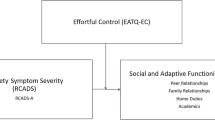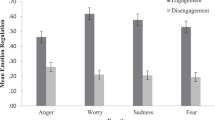Abstract
The present study investigated the interactive effect of reactive (negative emotionality) and regulatory (effortful control) aspects of temperament in the prediction of child anxiety and depressive symptoms. Clinically anxious children and their mothers completed a battery of questionnaires that included self- and mother-ratings of child effortful control, negative emotionality, anxiety, and depressive symptoms. Multiple regression analyses were conducted to examine the moderating effect of effortful control on the relation between negative emotionality and child anxiety and depressive symptom severity. The interaction between negative emotionality and effortful control was statistically significant and simple slopes revealed that as effortful control increased, the relationship between negative emotionality and anxiety and depressive symptoms weakened. Among anxious children high in negative emotionality, greater effortful control was related to less severe anxiety and depressive symptoms. Future work should evaluate whether targeting effortful control leads to reductions in internalizing symptoms among clinically anxious youth.

Similar content being viewed by others
References
Cummings CM, Caporino NE, Kendall PC (2014) Comorbidity of anxiety and depression in children and adolescents: 20 years after. Psychol Bull 140:816–845
Axelson DA, Birmaher B (2001) Relation between anxiety and depressive disorders in childhood and adolescence. Depress Anxiety 14:67–78
O’Neil KA, Podell JL, Benjamin CL, Kendall PC (2010) Comorbid depressive disorders in anxiety-disordered youth: demographic, clinical, and family characteristics. Child Psychiatry Hum Dev 41:330–341
Birmaher B, Ryan ND, Williamson DE, Brent DA, Kaufman J, Dahl RE, Perel J, Nelson B (1996) Childhood and adolescent depression: a review of the past 10 years. Part I. J Am Acad Child Adolesc Psychiatry 35:1427–1439
Garber J, Weersing VR (2010) Comorbidity of anxiety and depression in youth: implications for treatment and prevention. Clin Psychol Sci Pract 17:293–306
Kendall PC, Cummings CM, Villabø MA, Narayanan MK, Treadwell K, Birmaher B, Compton S, Piacentini J, Sherrill J, Walkup J (2016) Mediators of change in the Child/Adolescent Anxiety Multimodal Treatment Study. J Consult Clin Psychol 84:1
Rothbart MK, Bates JE (1998) Temperament. In: Eisenberg N (ed) Handbook of child psychology: social, emotional, and personality development. John Wiley & Sons Inc, Hoboken, pp 105–176
Bridgett DJ, Gartstein MA, Putnam SP, Lance KO, Iddins E, Waits R, VanVleet J, Lee L (2011) Emerging effortful control in toddlerhood: the role of infant orienting/regulation, maternal effortful control, and maternal time spent in caregiving activities. Infant Behav Dev 34:189–199
Fox NA, Calkins SD (2003) The development of self-control of emotion: Intrinsic and extrinsic influences. Motiv Emot 27:7–26
Muris P, Ollendick TH (2005) The role of temperament in the etiology of child psychopathology. Clin Child Fam Psychol 8:271–289
Nielsen JD, Olino TM, Dyson MW, Klein DN (2019) Reactive and regulatory temperament: longitudinal associations with internalizing and externalizing symptoms through childhood. J Abnorm Child Psychol 47:1771–1784
Clark LA, Watson D (1991) Tripartite model of anxiety and depression: psychometric evidence and taxonomic implications. J Abnorm Psychol 100:316–336
Lonigan CJ, Hooe ES, David CF, Kistner JA (1999) Positive and negative affectivity in children: confirmatory factor analysis of a two-factor model and its relation to symptoms of anxiety and depression. J Consult Clin Psychol 67:374
Hagan MJ, Luecken LJ, Modecki KL, Sandler IN, Wolchik SA (2016) Childhood negative emotionality predicts biobehavioral dysregulation fifteen years later. Emotion 16:877
Stanton K, Watson D (2014) Positive and negative affective dysfunction in psychopathology. Soc Pers Psychol Compass 8:555–567
Compas BE, Connor-Smith JK, Saltzman H, Thomsen AH, Wadsworth ME (2001) Co** with stress during childhood and adolescence: problems, progress, and potential in theory and research. Psychol Bull 127:87
Lengua LJ (2002) The contribution of emotionality and self-regulation to the understanding of children’s response to multiple risk. Child Dev 73:144–161
Gulley LD, Hankin BL, Young JF (2016) Risk for depression and anxiety in youth: the interaction between negative affectivity, effortful control, and stressors. J Abnorm Child Psychol 44:207–218
Rothbart MK, Bates JE (2006) Temperament. In: Eisenberg N, Damon W, Lerner RM (eds) Handbook of child psychology: Vol 3, social, emotional, and personality development, 6th edn. John Wiley & Sons Inc, Hoboken, pp 99–166
Lonigan CJ, Vasey MW (2009) Negative affectivity, effortful control, and attention to threat-relevant stimuli. J Abnorm Child Psychol 37:387–399
White LK, McDermott JM, Degnan KA, Henderson HA, Fox NA (2011) Behavioral inhibition and anxiety: The moderating roles of inhibitory control and attention shifting. J Abnorm Child Psychol 39:735–747
Raines EM, Viana AG, Trent ES, Woodward EC, Candelari AE, Zvolensky MJ, Storch EA (2019) Effortful control, interpretation biases, and child anxiety symptom severity in a sample of children with anxiety disorders. J Anxiety Disord 67:102136
Eisenberg N, Hofer C, Vaughan J (2007) Effortful control and its socioemotional consequences. In: Gross JJ (ed) Handbook of emotion regulation. Guilford, New York, pp 287–288
Niditch LA, Varela RE (2018) A longitudinal study of inhibited temperament, effortful control, gender, and anxiety in early childhood. In: Child & youth care forum. Springer, Berlin
Kotelnikova Y, Mackrell SVM, Jordan PL, Hayden EP (2015) Longitudinal associations between reactive and regulatory temperament traits and depressive symptoms in middle childhood. J Clin Child Adolesc Psychol 44:775–786
Eysenck MW, Derakshan N, Santos R, Calvo MG (2007) Anxiety and cognitive performance: attentional control theory. Emotion 7:336
Eisenberg N, Cumberland A, Spinrad TL, Fabes RA, Shepard SA, Reiser M, Murphy BC, Losoya SH, Guthrie IK (2001) The relations of regulation and emotionality to children’s externalizing and internalizing problem behavior. Child Dev 72:1112–1134
Eisenberg N, Fabes RA, Guthrie IK, Murphy BC, Maszk P, Holmgren R, Suh K (1996) The relations of regulation and emotionality to problem behavior in elementary school children. Dev Psychopathol 8:141–162
Rosellini AJ, Boettcher H, Brown TA, Barlow DH (2015) A transdiagnostic temperament-phenotype profile approach to emotional disorder classification: an update. Psychopathol Rev 2:110–128
Lovibond PF, Lovibond SH (1995) The structure of negative emotional states: comparison of the Depression Anxiety Stress Scales (DASS) with the Beck Depression and Anxiety Inventories. Behav Res Ther 33:335–343
U.S. Census Bureau (2015) Annual estimates of the resident population for selected age groups by sex for the United States, States, Counties, and Puerto Rico Commonwealth and Municipios: April 1, 2010 to July 1, 2015: 2015 Population Estimates. Accessed 2015
American Psychiatric Association (2013) Diagnostic and statistical manual of mental disorders: DSM-5. Author, Washington, DC
Zvolensky MJ, Rogers AH, Bakhshaie J, Viana AG, Walker R, Mayorga NA, Lopez K, Garza M, Lemaire C, Ruiz AC (2019) Perceived racial discrimination, anxiety sensitivity, and mental health among Latinos in a federally qualified health center. Stigma Health 4:473
Ellis LK, Rothbart MK (2001) Revision of the Early Adolescent Temperament Questionnaire. Biennial Meeting of the Society for Research in Child Development, Minneapolis
Snyder HR, Gulley LD, Bijttebier P, Hartman CA, Oldehinkel AJ, Mezulis A, Young JF, Hankin BL (2015) Adolescent emotionality and effortful control: core latent constructs and links to psychopathology and functioning. J Pers Soc Psychol 109:1132
Morris AS, Age TR (2009) Adjustment among youth in military families: the protective roles of effortful control and maternal social support. J Appl Dev Psychol 30:695–707
Chorpita BF, Yim L, Moffitt C, Umemoto LA, Francis SE (2000) Assessment of symptoms of DSM-IV anxiety and depression in children: a revised child anxiety and depression scale. Behav Res Ther 38:835–855
Spence SH (1998) A measure of anxiety symptoms among children. Behav Res Ther 36:545–566
American Psychiatric Association (2000) Diagnostic and statistical manual of mental disorders, 4th, text revision edn, Washington, DC
Chorpita BF, Moffitt CE, Gray J (2005) Psychometric properties of the Revised Child Anxiety and Depression Scale in a clinical sample. Behav Res Ther 43:309–322
Hayes AF (2018) Introduction to mediation, moderation, and conditional process analysis: a regression-based approach. Guilford Publications, New York
Cohen J, Cohen P (1983) Applied multiple regression/correlation analysis for the behavioral sciences. L. Erlbaum Associates, Hillsdale
Holmbeck GN (2002) Post-hoc probing of significant moderational and mediational effects in studies of pediatric populations. J Pediatr Psychol 27:87–96
Tabachnick BG, Fidell LS (2013) Using multivariate statistics, 6th edn. Pearson Education, Boston
Chorpita BF (2002) The tripartite model and dimensions of anxiety and depression: an examination of structure in a large school sample. J Abnorm Child Psychol 30:177–190
Fox NA, Buzzell GA, Morales S, Valadez EA, Wilson M, Henderson HA (2020) Understanding the emergence of social anxiety in children with behavioral inhibition. Biol Psychiatry. https://doi.org/10.1016/j.biopsych.2020.10.004
Muris P, van der Pennen E, Sigmond R, Mayer B (2008) Symptoms of anxiety, depression, and aggression in non-clinical children: relationships with self-report and performance-based measures of attention and effortful control. Child Psychiatry Hum Dev 39:455–467
Diamond A, Barnett WS, Thomas J, Munro S (2007) Preschool program improves cognitive control. Science 318:1387
Blair C, Raver CC (2014) Closing the achievement gap through modification of neurocognitive and neuroendocrine function: results from a cluster randomized controlled trial of an innovative approach to the education of children in kindergarten. PLoS ONE 9:e112393
Diamond A, Ling DS (2016) Conclusions about interventions, programs, and approaches for improving executive functions that appear justified and those that, despite much hype, do not. Dev Cogn Neurosci 18:34–48
Acknowledgements
This work was supported by the National Institute of Mental Health [R21-MH101309-01A1; NCT02095340; PI: Viana]. The views articulated in this article are those of the authors and do not necessarily reflect the views of the National Institutes of Health or National Institute of Mental Health.
Funding
This study was funded by the National Instutute of Mental Health (R21-MH101309-01A1; NCT02095340).
Author information
Authors and Affiliations
Corresponding author
Ethics declarations
Conflict of interest
The authors report no conflict of interest.
Ethical Approval
All procedures performed in studies involving human participants were in accordance with the ethical standards of the institutional and/or national research committee and with the 1964 Helsinki declaration and its later amendments or comparable ethical standards.
Additional information
Publisher's Note
Springer Nature remains neutral with regard to jurisdictional claims in published maps and institutional affiliations.
Rights and permissions
About this article
Cite this article
Raines, E.M., Viana, A.G., Trent, E.S. et al. Effortful Control Moderates the Relation Between Negative Emotionality and Child Anxiety and Depressive Symptom Severity in Children with Anxiety Disorders. Child Psychiatry Hum Dev 54, 17–25 (2023). https://doi.org/10.1007/s10578-021-01218-2
Accepted:
Published:
Issue Date:
DOI: https://doi.org/10.1007/s10578-021-01218-2




